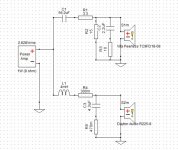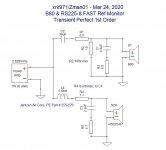Hi kking, good that you have made a prototype - I think something went wrong. I recommend to to check it again.I started with a mixed cut list (never a good thing, as one had the sides tucked under the top and the other did not) and the prototype has a bunch of wrong sized panels, which is why I try to prototype before cutting expensive lumber... But now I can verify all my cuts and notice little things to fix and adjust. It also allowed my wife to look at the basic shape and size and give it the green light.
Quick question - I've seen radii listed for the routing and the holes for the front, but not for how deep the routing (at the edge) should be. Do we want the speakers flush with the wood? Or is there some other measurement to use for the depth of the routing for the outer ring?
I see at least two issues, one is the middle plate behind the speakers, it is way too short and should reach much higher, the other one is the bass opening under the speaker, it is too broad (or high), the TL should be the narrowest here, as it must have a decreasing cross-section, from the speaker to the output.
Looks great Tuba!Finished my sealed RS225/TC9FD. Because I'm cheap I used 3/4" subfloor material from all the construction in my neighborhood. Heavy and dense, maybe even heavier than MDF. So far sounding good. Kept standard tweeter attenuation even though TC9FD less efficient than 10F/8424 because brightness bothers me. Used a cheaper Dayton iron core 4 mh inductor and wondering if I should upgrade. Used it because I had it. What difference would I hear? Thanks to X for such a well documented project!!
Hi X,
sadly the circuit diagram of the xo is not available (and I forgot to print it...), so a short question: with which resistor should I play to change/decrease the brightness of the B80? Thanks in advance.
sadly the circuit diagram of the xo is not available (and I forgot to print it...), so a short question: with which resistor should I play to change/decrease the brightness of the B80? Thanks in advance.
Plott - if it helps, the XO schematic survives in post 2866Hi X,
sadly the circuit diagram of the xo is not available...
Simon
Then maybe this? Here: https://www.diyaudio.com/community/...-waw-ref-monitor.273524/page-117#post-6139160
Attachments
Great, many thanks

So to be sure I understand: Keep R1 at 4.7 and raise R2 to 6.8 for a little less attenuation on the TC9FD. I'm finding myself wanting a little more shimmer on cymbals, etc. I want to be sure before tearing into my XO. Thanks.10F and B80 are about equal and comes down to preference for glass vs paper cone sound. TC9FD is slightly less sensitive than 10F, so maybe 4.7R/6.8R resistor divider on the tweeter (6.8R to ground and 4.7R to the driver) in order to attenuate it less. You can adjust by ear to your liking.
I'm seeing on the woofer there is a 3.5mh inductor instead of the usual 4mh. Is there a reason why it is different?
Nareshseep - X must have calculated that a slightly higher crossover point was warranted when using the B80. Note that he also suggests using a 36uF capacitor with the B80, instead of the 61uF designed for the 10F/8424; all part of the "dark arts" of crossover design - at least to me! 😉I'm seeing on the woofer there is a 3.5mh inductor instead of the usual 4mh. Is there a reason why it is different?
By the way, my own ""practice build" of a sealed pair is coming along, using Vifa TC9FD18-08s, in 12mm ply. I've used a Jantzen iron core inductor (dcr of 0.29R) and an electrolytic 56uF cap for the Vifa - plus I played with the resistors a little, just for fun. If this sounds half decent, I will give it to my son for Christmas - and then build me a set of floorstanders with the 10F/8424s I bought 🙂.
Simon
Thanks Simonism for the information, I understand...it really is crossover "dark science" , one day I will understand it all. Your sealed set looks decent... I'm looking to build a pair of the tlines... I will use the tc9 for now... And possibly the 10F in the future... A little bit at a time.
Great work Simon! Your son is a lucky kid. I can’t imagine having this kind of sound quality on my speakers when I was a kid. My kids all have nice speakers that I designed nowadays of course. I don’t think they know what bad audio from mediocre speakers sounds like.
My daughter has a set of the 10F/RS225 FAST for her apartment. She has a set of the micro FAST with FR58EX/AC130F1 bookshelf speakers for her bedroom. My son has some open desktop baffles with FR58EX’s and XKi subwoofers in his room.
The FR58EX is a good driver too. The earlier ones were better. Later ones have a 10kHz tizzy sound breakup.
Crossover design requires some experience, practical knowledge, and some of it is an “art” of course - but the work is very methodical and process oriented. The experience one acquires makes each successive design a bit better with the tools learned from earlier builds. With the advent of tools like Xsim by Bwaslo and REW by John Mulcahy, anyone can do it if you put the time into learning how. The learning curve can be steep and long though. Sort of like learning Akabak. The B80 could work in a standard 10F/RS225 XO with some resistor changes of course. But it was a special case where I was asked by Zman01 to optimize it for the best integration.
One of the best $200 I ever spent was to buy almost a complete set of typical inductors, capacitors, and resistors one could need for any crossover build. Have this development set on hand and you assemble any crossover that you come up with in Xsim in 10min and tweak with listening sessions in the same night. This has vastly improved my ability to make crossovers quickly and accurately.
Here is my crossover development kit. It’s grown a bit so maybe $300 worth of parts now. Bit that’s not needed to get started.

My daughter has a set of the 10F/RS225 FAST for her apartment. She has a set of the micro FAST with FR58EX/AC130F1 bookshelf speakers for her bedroom. My son has some open desktop baffles with FR58EX’s and XKi subwoofers in his room.
The FR58EX is a good driver too. The earlier ones were better. Later ones have a 10kHz tizzy sound breakup.
Crossover design requires some experience, practical knowledge, and some of it is an “art” of course - but the work is very methodical and process oriented. The experience one acquires makes each successive design a bit better with the tools learned from earlier builds. With the advent of tools like Xsim by Bwaslo and REW by John Mulcahy, anyone can do it if you put the time into learning how. The learning curve can be steep and long though. Sort of like learning Akabak. The B80 could work in a standard 10F/RS225 XO with some resistor changes of course. But it was a special case where I was asked by Zman01 to optimize it for the best integration.
One of the best $200 I ever spent was to buy almost a complete set of typical inductors, capacitors, and resistors one could need for any crossover build. Have this development set on hand and you assemble any crossover that you come up with in Xsim in 10min and tweak with listening sessions in the same night. This has vastly improved my ability to make crossovers quickly and accurately.
Here is my crossover development kit. It’s grown a bit so maybe $300 worth of parts now. Bit that’s not needed to get started.
Last edited:
Big THANKS to X! I'm pretty chuffed - these turned out great. The low intrinsic resistance of the iron core inductor brings out a bit more bass. Pretty happy with my minor crossover adjustments. The sound quality is magnificent, with crisp powerful bass transitioning to the great highs that the TC9 can produce. Wow. So now I just need to apply a simple finish to the boxes, and package them up.
Next stop ... floorstanders in 18mm birch ply. Can't wait.

Simon
Next stop ... floorstanders in 18mm birch ply. Can't wait.

Simon
That sounds great, Simon. Wait until you hear the floorstanding TL’s. The TC9 does indeed sound very very good. Amazing sound for a $10 driver. But really it is the RS225 that is the star. 80% of the audio power is coming from the woofer which is also operating in the midrange here.
The track you chose really showcases the “transient perfect” crossover well with all the percussion. The timing is great and finger snappin’ good. 🤌
Thanks for making a YT video
you have a nice collection of speakers there. I see the Manzanita’s with a TC9 also. How does this speaker compare to the Manzanita in subjective terms?
The track you chose really showcases the “transient perfect” crossover well with all the percussion. The timing is great and finger snappin’ good. 🤌
Thanks for making a YT video
you have a nice collection of speakers there. I see the Manzanita’s with a TC9 also. How does this speaker compare to the Manzanita in subjective terms?
Last edited:
The Manzanitas have been a lot of fun - built from 100% trashed materials - and deliver surprisingly well from their simple OB format. They are slightly less efficient than these WAWs, so less loud on the same setting. The upper-mids to highs are very much on par but the mids and bass from the WAWs work extremely well and the bass packs a decent punch in the jazz I like. The Manzanitas cross up from the Peerless SLS 830669 woofer really very low (they're on a 20mH coil!) so the TC9s have quite a bit of work to do that I think the RS225 drivers can carry off better in this design.I see the Manzanita’s with a TC9 also. How does this speaker compare to the Manzanita in subjective terms?
I like the RS225s - just as you've been telling us. I can see that, when built, the TLs will be keepers for a yet-to-come SS amp (the little AIYIMA A08 in the video will go with these sealed WAWs to my son, after I re-case it).
Thanks gain for sharing your adventures and know-how with your (many) super projects!
Simon
Great work, Simon! You like your monitors... but you will love the floorstanders, I promise!🙂
-------
To my earlier post regarding changing the "brightness" (which is not really here), or just playing around with the settings: in about 25° to the listening position are the upper mids now perfect (so no rocket science needed, no change of the xo).
-------
To my earlier post regarding changing the "brightness" (which is not really here), or just playing around with the settings: in about 25° to the listening position are the upper mids now perfect (so no rocket science needed, no change of the xo).
Hi Gabor,Excellent thread, spent several hours to read it.
Great speakers.......
What are your current speakers? Perhaps you should give these a try? They are keepers for sure. Like Simon has found out, a $10 TC9 on top works well. You just need to find some RS225-8’s in Toronto! I’ll even send you some XO PCBs if you can find the woofers.
Cheers,
X
- Home
- Loudspeakers
- Full Range
- 10F/8424 & RS225-8 FAST / WAW Ref Monitor
